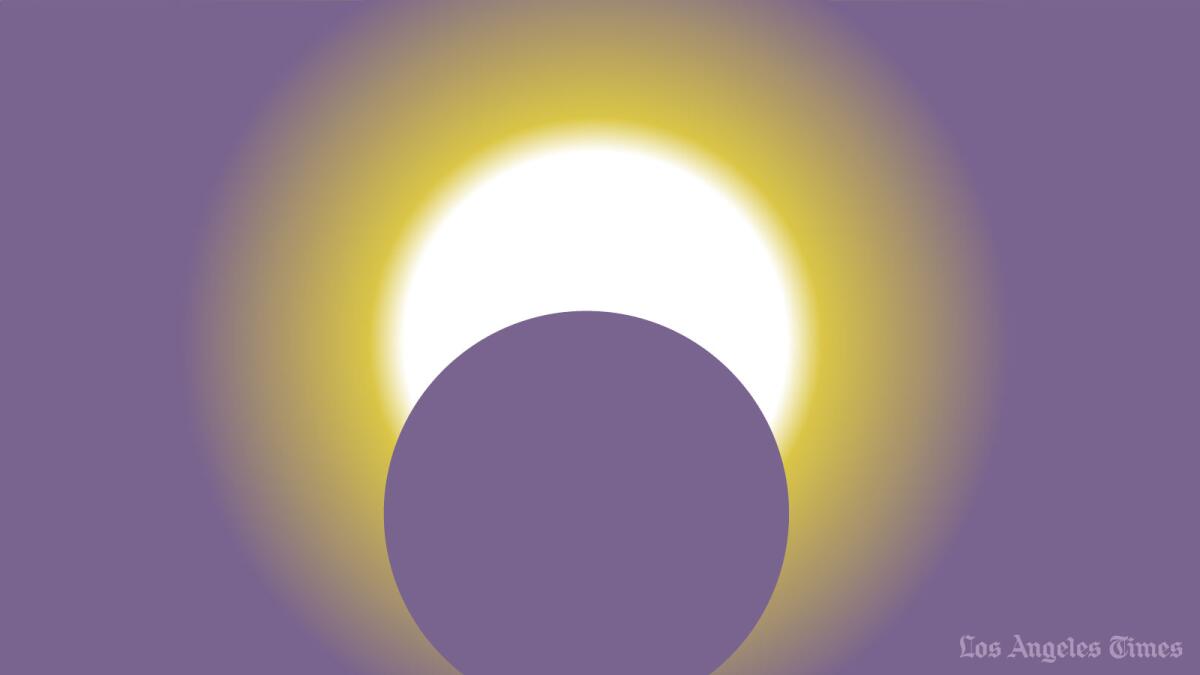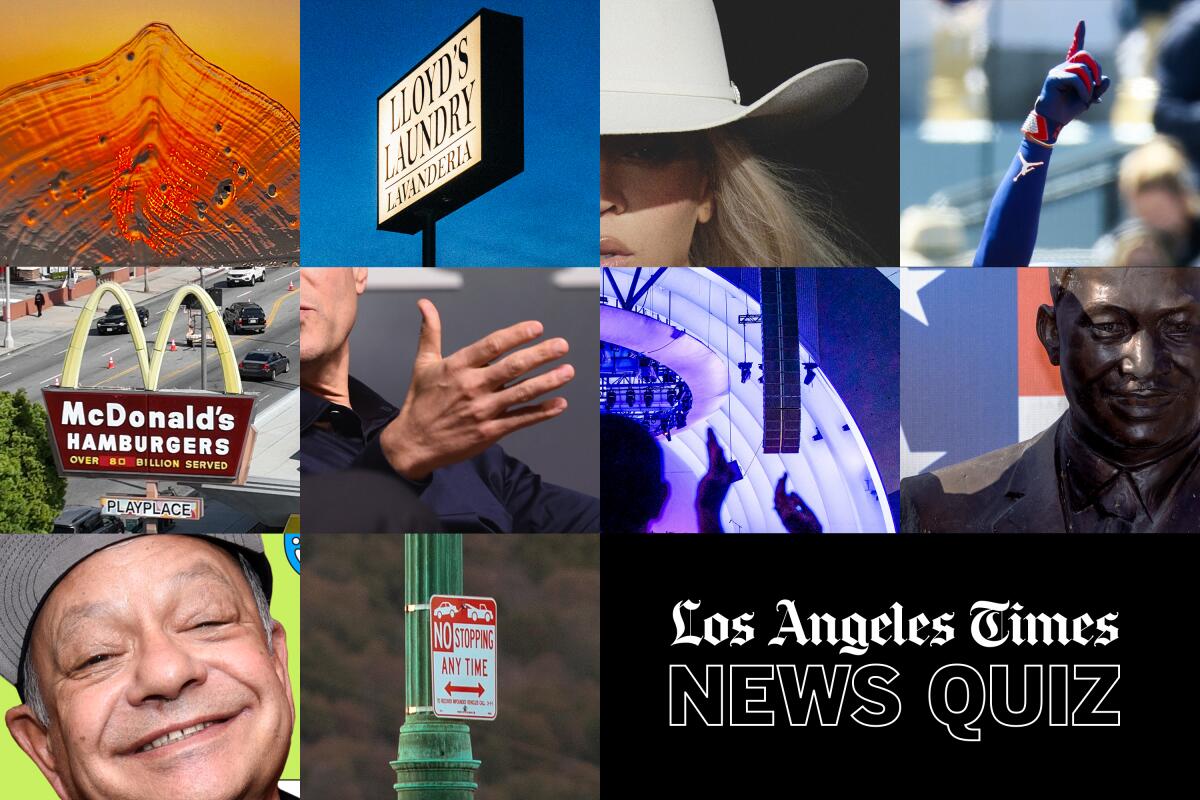Going to miss the solar eclipse? Don’t worry, the next one is only years away

Good morning, and welcome to the Essential California newsletter. It’s Saturday, April 6. Here’s what you need to know to start your weekend:
- The solar eclipse is Monday.
- In one of L.A.’s largest cash heists ever, burglars stole as much as $30 million from vault.
- 🌉 9 lovely walks to explore L.A.’s most beautiful bridges.
- And here’s today’s e-newspaper
Sign up for Essential California
The most important California stories and recommendations in your inbox every morning.
You may occasionally receive promotional content from the Los Angeles Times.
Avoid four simple mistakes to make the most of Monday’s solar eclipse
For 4 minutes and 28 seconds on Monday, day will become night for 31.5 million people. From Niagara Falls to Mazatlán, Mexico, along the “path of totality” a total solar eclipse will blot out the sun.
Temperatures drop suddenly. The sun’s corona, which is usually impossible to see creates a spectacular view.
California is not in the path of totality. Even if the chilly storms and rains headed our way clear, we will only get to see a partial eclipse. The sun and the moon won’t be perfectly aligned.
For Angelenos, the moon will visibly cover half of the sun. In San Francisco, only a third.
Maybe that sounds disappointing. But waiting five years until the next partial solar eclipse (or 20 until the next total one) would probably be worse.
So, get out there. Take a break. Enjoy the hopefully decent weather and bask in the partial darkness.
But be careful. Solar eclipses have rules.
Don’t miss the window
In Los Angeles the eclipse will begin at 10:06 a.m. By 10:39 a.m. the moon will take a substantial bite of the sun, peaking at 11:12 a.m. It will be over by 12:22 p.m, according to the Griffith Observatory.
NASA offers an eclipse explorer map.
There are many eclipse viewing parties around Los Angeles (between 10:00 a.m. and noon), where you can ask astrophysicists questions or look at the eclipse through solar telescopes.
Don’t forget your solar viewers or eclipse glasses
“It is very dangerous to look at the partially eclipsed sun directly with your own eyes,” Ed Krupp, the longtime director of the Griffith Observatory, told my colleague Rong-Gong Lin II. “You’re tempted to do it, but it will burn the retinas permanently and cause permanent blindness.”
Those in the zone of totality can remove their eclipse glasses and watch the total eclipse with a naked eye, NASA says. But only for the minute or two that totality lasts.
It’s also unsafe to look at the eclipse through a camera lens, binoculars, telescope or regular sunglasses. You need solar viewers or eclipse glasses that comply with the ISO 12312-2 international standard.
The American Astronomical Society has a list of reputable suppliers of eclipse glasses, filters and viewers.
The Los Angeles Public Library will be distributing more than 20,000 eclipse glasses for free at the L.A. Maker Faire today at the L.A. State Historic Park in Chinatown.
Some Warby Parker locations (here’s a list) are also handing out free solar eclipse glasses.
Don’t bother trying to take a photo (but if you want to, here are some tips)
It’s quite challenging to get a “good” photo of an eclipse, especially of totality. The rapid change from daylight to twilight darkness requires technical adaptability.
But here’s your best bet: Use your eclipse glasses or a certified solar filter over the camera lens.
You can also use a black tape or a cloth to cut down on the light between the solar filter and the lens.
“We would not recommend pointing [your phone’s camera] directly at the sun for extended periods of time with no filter,” Google’s Pixel camera team told my colleague Ron.
You can equally enjoy the experience by putting your phone down, looking at how other people are reacting and noticing the changes in nature.
Speaking of nature...
Don’t forget that it’s still daytime (some animals will forget)
The Great American Eclipse of 2017 mystified tiny marine creatures known as zooplankton.
“One hour before the sky went dark, the confused little critters began swimming up the water column to start their nighttime feeding routine,” wrote my colleague Deborah Netburn. “As soon as totality was over” they “made their way back to the safety of deeper, darker waters,” realizing their mistake.
This time, researchers and scientists will observe how the solar eclipse will interfere with the routines of animals at Texas’ Fort Worth Zoo.
“It’s sort of adorable, this whole colony of tiny little creatures being like, ‘Oooh, nighttime!’ and then a few minutes later they’re like, ‘Oops,’” solar physicist Dan Seaton told Deborah in 2017. “It’s all part of the magic of eclipses.”
Read more
- How to avoid heartbreak if chasing ‘totality.’
- What you need to do to watch safely.
- 6 excellent L.A. spots to watch the awe-inspiring solar eclipse.
The week’s biggest stories

L.A. heists
- In one of L.A.’s largest cash heists ever, burglars stole as much as $30 million from the Sylmar vault.
- A neighbor heard odd noises amid the heist.
- The perfect heist? Theft of up to $30 million from L.A. vault was seamless, sophisticated, stealthy.
- Thief who finagled luxury hotel room keys admits to brazen diamond necklace heist.
- These are the 5 best L.A. heist movies.
Are you ready for Coachella?
- Here’s everything you need to know about the festival.
- It took Bradley Nowell’s son years to embrace Sublime. Now he’ll lead the band at Coachella.
- Young Miko is preparing for the biggest month of her life. First, the release of her long-awaited debut album, ‘att.’ Then, a set at Coachella.
- 25 of the best restaurants and bars for your Palm Springs or Coachella road trip.
- 2024 Coachella food lineup is stacked with heavy hitters from L.A.’s dining scene.
Ohtani and the Dodgers
- Dodgers diehards caught Ohtani’s historic homer. But a priceless moment quickly turned ugly.
- Japanese treat Shohei Ohtani gambling scandal like ‘presidential election.’ Media take his side.
- Inside the gambling ring linked to Ohtani — as told by two bettors themselves.
More big stories
- Part of Highway 1 near Big Sur crumbled as new landslide closes more of historic roadway.
- California’s wealthiest farm family — and scores of their workers — accused UFW of bait and trick.
- Trash outside L.A. home drew complaints, the producer of ‘Hoarders’ — and now Mayor Bass.
- L.A. tests program to send unarmed civilians instead of cops to people in crisis.
- A San Diego ‘miracle dog’ has been found months later in suburban Michigan.
- How long can Santa Anita Park survive?
- Bronny James declared for NBA draft.
- To crack down on tee time brokers, L.A. golf courses will require $10 deposit.
- Rattlesnakes on Santa Catalina Island have learned that it pays to be unusually aggressive.
- Bruno Mars to open Inglewood’s Intuit Dome in August.
- ‘Game of Thrones’ actor sues LAPD and L.A. County over false pedophile case.
- Sean Combs’ son Christian accused of sexual assault on yacht Diddy chartered.
Get unlimited access to the Los Angeles Times. Subscribe here.
Column One
Column One is The Times’ home for narrative and longform journalism. Here’s a great piece from this week:

Lost and found: Should California return Cambodia’s stolen art?
Thousands of precious antiquities disappeared from Cambodia during decades of war and strife. Now the country is taking on California museums to get them back.
More great reads
- Swifty Blue raps about L.A. gang life — and finds himself dodging real-life violence.
- Andy Cohen turned Bravo into a cable powerhouse. Now the ‘king of reality TV’ faces his own drama.
How can we make this newsletter more useful? Send comments to [email protected].
For your weekend

Going out
- 🌉 9 lovely walks to explore L.A.’s most beautiful bridges.
- 🍽️ The best places to eat and drink in L.A. this month, according to our food writers.
- 👀 Your guide for what to see, shop and journey for in April.
Staying in
- 📚 3 best mystery books to read this spring.
- 🧑🍳 Here’s a recipe for creamy white beans in coconut broth.
- ✏️ Get our free daily crossword puzzle, sudoku, word search and arcade games.
How well did you follow the news this week? Take our quiz.
Which avian-named team did Los Angeles defeat soundly in front of a crowd of 52,667 in the Dodgers’ home opener? Plus nine other questions in our weekly news quiz.
Have a great weekend, from the Essential California team
Check our top stories, topics and the latest articles on latimes.com.
Sign up for Essential California
The most important California stories and recommendations in your inbox every morning.
You may occasionally receive promotional content from the Los Angeles Times.





